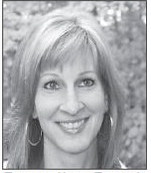Midnight in the Garden


I can still picture them on that Victorian couch, a scene frozen in time yet vivid in my memory. My mother-in-law, Margaret Nagle, with her legs folded to the side, cigarette poised between her fingers, a small plume of smoke curling upward as she turned another page of a book. My father-in-law, George Nagle, opposite her, deeply absorbed in his own book, with two impressive ponytail palms in the background and the late afternoon light filtering through their Chattanooga home’s tall windows. This was their natural state — surrounded by words and stories and antiques and PBS shows, silently sharing space while journeying through different literary worlds.
It was during one of our visits to Chattanooga around 1995 when they couldn’t stop talking about a book they’d both just finished.
“Amber, you absolutely must read this,” Margaret insisted, tapping her finger on the cover featuring a haunting statue of a young girl holding two bowls in her upturned hands. I’d later learn that the statue was, The Bird Girl, and the bowls were intended to hold seeds and water for birds. “The book is set near Savannah, and the statue on the cover is in Bonaventure Cemetery in Savannah. You have family in that area, don’t you?”
“Yes,” I replied, picking up the book and flipping it over to the back cover to read the description.
George nodded in agreement. “The characters are extraordinary — absolutely extraordinary.” Coming from my father-in-law, a psychologist who’d spent decades working with veterans and studying human behavior, this was an endorsement that carried weight.
The two chattered on about the book for an hour, and so, the next week, I found myself at a local bookstore purchasing my own copy of “Midnight in the Garden of Good and Evil” by John Berendt.
The story pulled me in immediately — the mysterious shooting at a Savannah mansion, the eccentric cast of characters from the high-society card ladies to the unapologetic drag queen, and a voodoo priestess working midnight magic in the cemetery. Through Berendt’s masterful storytelling, I was transported to mossdraped squares and hidden gardens where good and evil existed in delicate balance.
When I finished reading, I understood why Margaret and George had been so enthusiastic. The book captured some of the classic Southern eccentricity that I have always loved. Margaret, with her New York upbringing and sharp wit, recognized in these pages a celebration of individualism and local color. George, who’d traveled from Montana to California to Texas to Tennessee and from being a Catholic priest to an award-winning psychologist, appreciated the deep psychological portraits and moral complexities.
The book became a cultural phenomenon, remaining on the New continued from page
York Times Best-Seller list for 216 weeks. But for our family, it became something more personal — a shared literary experience that sparked conversations about place, character and the thin boundaries between good and evil in the city that launched Georgia’s history way back in 1733.
The Bird Girl statue on the cover became particularly significant to Margaret, and she surrounded herself with replicas, including a small blue resin version. She treasured it, displaying it prominently among her most valued possessions in their den.
Years passed. George retired against his will from his beloved VA work, falling into a deep, dark depression before his death in 2009. When we moved Margaret to an assisted living facility that same year, the tiny Bird Girl replica went with her — a talisman of happier times. As she neared the end of her life in 2012, I asked if I could have the replica when she was gone.
“Absolutely. You appreciated the book as much as we did. Of course I want you to have it,” she told me, her voice weak but her mind still sharp that day.
Today, that small blue Bird Girl watches over my office from a bookshelf, while a cement version stands guard in my front garden. They’re more than decorations — they’re memory keepers. When I look at them, I’m transported back to that Victorian couch, to Margaret with her cigarette and Laura Ashley dress, to George drinking a glass of seltzer water while flipping through a museum catalogue and listening to opera.
I miss them — Margaret with her encyclopedic knowledge that could have won thousands of dollars had she appeared on Jeopardy, her love of silver and fine china, her passion for British royalty and Braves baseball; George with his fondness for cooking and his dedication to healing traumatized veterans, his transition from priest to psychologist to a sort of father figure for my husband and his sister.
The Bird Girl stands as silent witness to what remains when loved ones depart — stories shared, books passed from hand to hand, conversations that echo years later. In the garden of memory, midnight never comes, and those we’ve lost remain forever present, forever reading on that Victorian couch, forever recommending one more extraordinary book I simply must read.







out of
Posted on